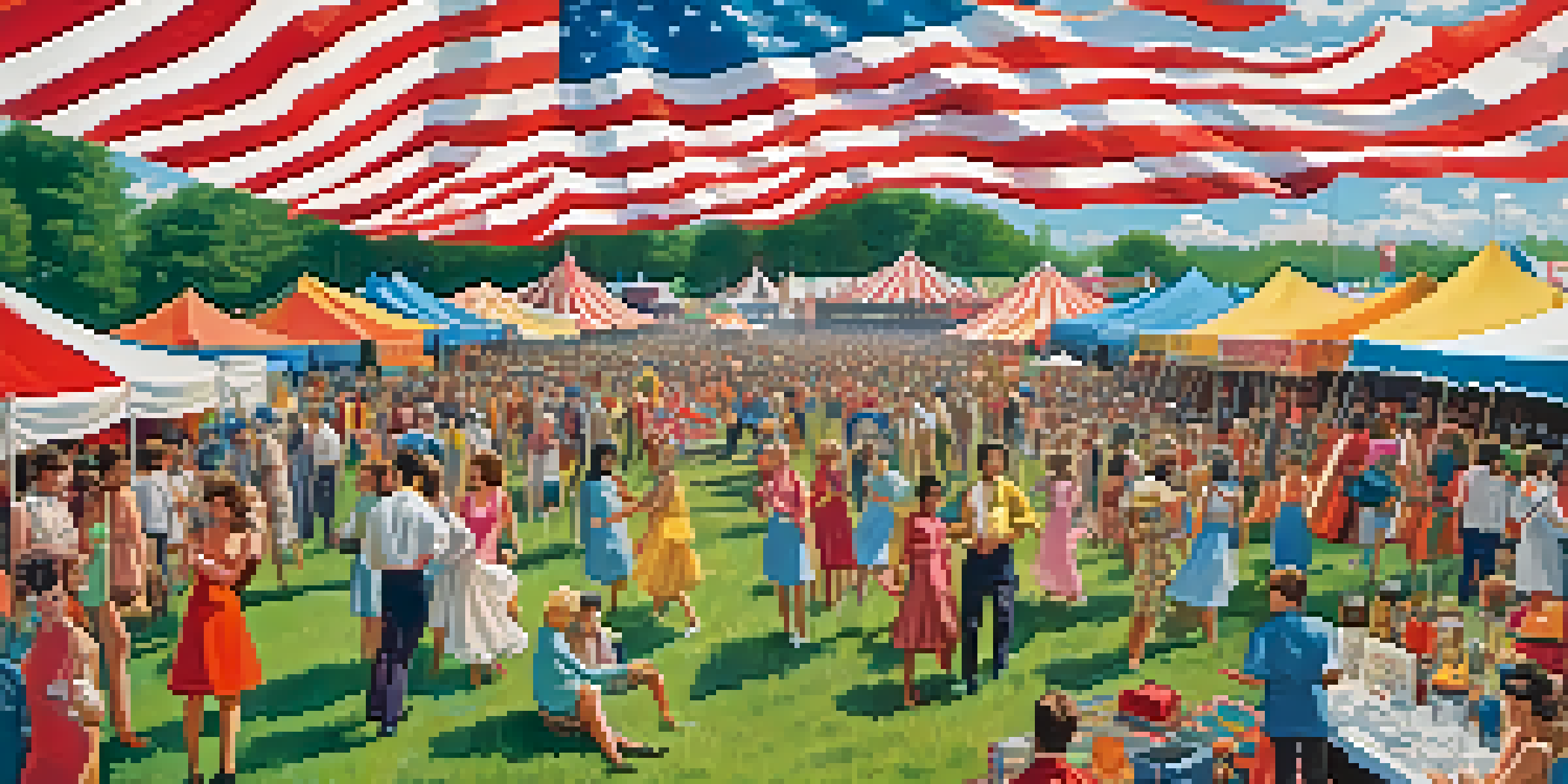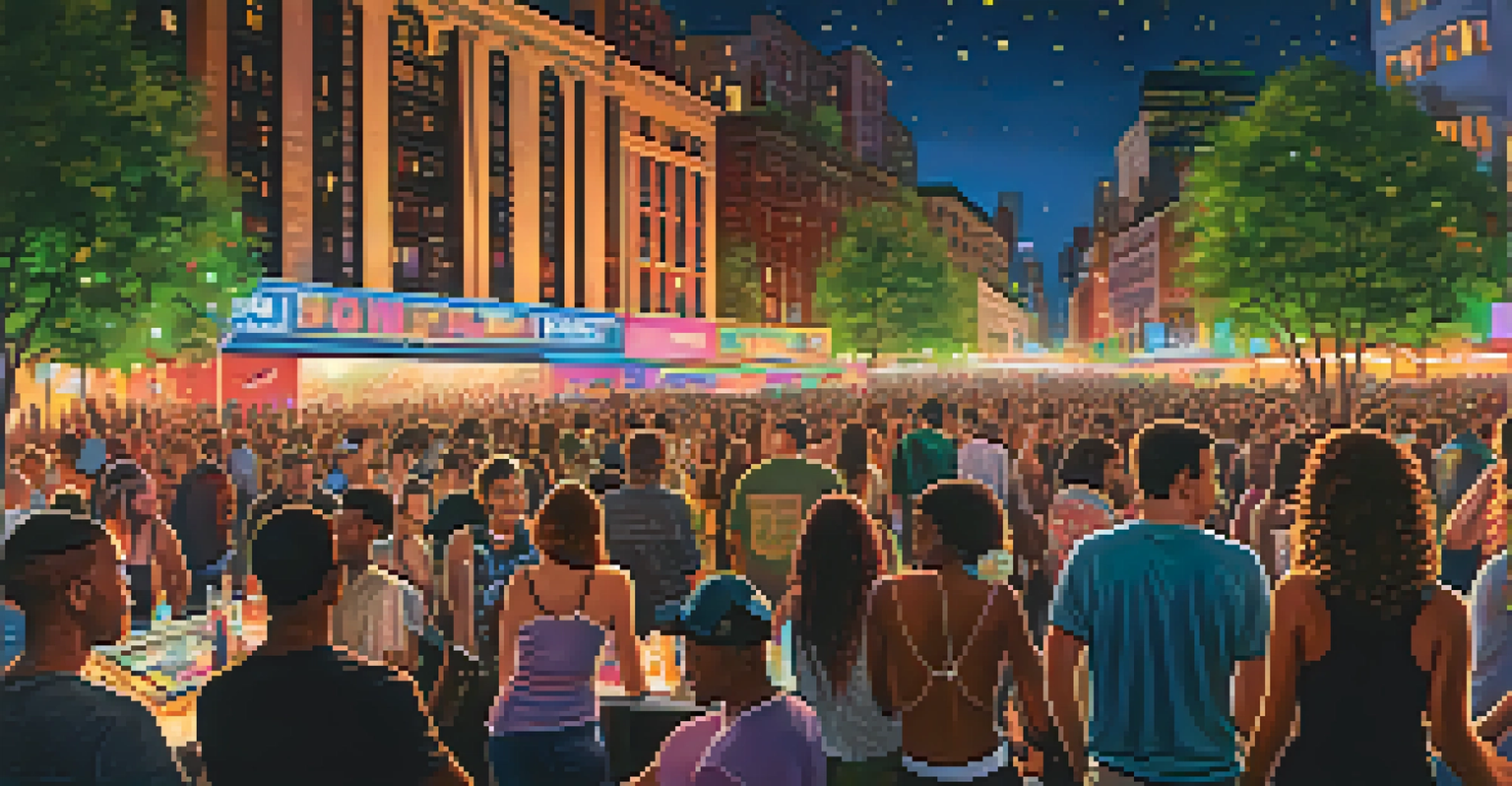The Evolution of Music Festivals in New York State

The Birth of Music Festivals in New York
Music festivals in New York State began to take shape in the late 1960s, with iconic events like Woodstock in 1969. This festival not only marked a cultural revolution but also set the stage for large-scale outdoor music gatherings. It attracted hundreds of thousands of attendees, showcasing a blend of music genres and counterculture ideals that resonated deeply with the youth. Woodstock became synonymous with peace, love, and rock 'n' roll, highlighting the power of music as a unifying force.
Music is the shorthand of emotion.
As the 1970s progressed, more festivals emerged, reflecting the diverse musical landscape of the time. Events like the Watkins Glen Summer Jam in 1973 featured legendary bands such as The Grateful Dead and The Allman Brothers Band, further establishing New York as a hub for music lovers. These festivals catered to the growing demand for live music experiences, offering an escape from everyday life and a chance to connect with others who shared a passion for sound.
The rise of these early festivals laid the groundwork for what would become a vibrant festival culture in New York. They not only provided entertainment but also fostered a sense of community among attendees. The idea of gathering in open spaces to celebrate music and culture began to take root, setting the stage for future generations of festivals.
The 1980s: A Decade of Diversification
The 1980s marked a significant shift in the music festival scene in New York, as the diversity of genres started to flourish. This decade saw the emergence of niche festivals that catered specifically to various musical tastes, from jazz and blues to punk and hip-hop. Festivals like the New York City Jazz Festival began to highlight the city’s rich musical heritage, giving artists a platform to showcase their talents while attracting a dedicated audience.

During this time, the concept of music festivals began to expand beyond just the music, incorporating art, food, and culture. The New York State Fair, for example, evolved into a multi-faceted event, blending live performances with local cuisine and crafts. This transformation made festivals more appealing to a broader audience, allowing families and individuals to engage in a variety of experiences beyond just the music.
Music Festivals Evolved in NY
From the iconic Woodstock in the 1960s to niche festivals in the 1980s, New York's music festivals have continually reflected the diverse cultural and musical landscape.
By the end of the 1980s, music festivals had firmly established themselves in New York's cultural landscape. They became a vital part of the state's identity, reflecting both its vibrant music scene and its commitment to inclusivity. This era set the stage for the explosive growth of festivals in the decades to come.
The 1990s: Rise of the Mega Festival
The 1990s ushered in a new era of music festivals in New York, characterized by the rise of mega festivals that drew massive crowds. Events like the Bonnaroo Music and Arts Festival, although based in Tennessee, influenced the format of festivals across the nation, including those in New York. The popularity of these large-scale events led to an increase in sponsorships and commercial partnerships, changing the financial landscape of festivals.
Without music, life would be a mistake.
During this period, the blending of genres became more pronounced, with festivals like the Lollapalooza tour showcasing an eclectic mix of alternative rock, hip-hop, and electronic music. This fusion not only attracted diverse audiences but also encouraged artists to collaborate across genres, fostering creativity and innovation in the music industry. The 1990s truly became a melting pot of musical styles and cultural expressions.
As festivals grew in size and complexity, they also faced challenges related to logistics, safety, and crowd management. Organizers had to navigate the intricacies of permitting, security, and infrastructure to ensure a positive experience for attendees. Despite these challenges, the growth of festivals in New York continued unabated, solidifying their place in the state's cultural fabric.
The 2000s: Technology and the Festival Experience
The 2000s brought about a technological revolution that significantly impacted music festivals in New York. With the advent of social media, festivals could now reach larger audiences, promote lineups, and create buzz like never before. Platforms like Facebook and Twitter became essential tools for marketing, allowing fans to engage with their favorite artists and share their experiences in real-time.
Additionally, advancements in technology transformed the festival experience itself. Innovations such as mobile apps for scheduling, cashless payment systems, and improved sound and lighting equipment enhanced the overall enjoyment for attendees. These technological upgrades not only streamlined operations but also set a new standard for what festival-goers could expect from their experiences.
Tech Transformed Festival Experiences
The integration of technology in the 2000s enhanced the festival experience, allowing for better engagement and improved logistics while promoting sustainability.
As the 2000s progressed, festivals began to embrace sustainability and eco-friendliness, reflecting a growing awareness of environmental issues. Many events adopted greener practices, such as waste reduction initiatives and the promotion of public transportation. This focus on sustainability resonated with younger audiences, who appreciated festivals that aligned with their values.
The 2010s: Inclusivity and Genre Expansion
The 2010s saw a continued emphasis on inclusivity and diversity within the festival scene in New York. Organizers began to prioritize representation, ensuring that lineups featured a wide range of artists from various backgrounds and genres. Festivals like Afropunk celebrated the contributions of Black artists and culture, creating spaces where underrepresented voices could shine.
Moreover, the festival landscape began to expand beyond traditional genres, embracing everything from electronic dance music (EDM) to indie rock and beyond. This genre-blending approach allowed festivals to attract diverse crowds, creating a vibrant atmosphere where attendees could discover new music and connect with fellow fans. Events like Electric Zoo became staples in the EDM scene, drawing in thousands of enthusiasts each year.
The 2010s also marked the rise of boutique festivals, which offered curated experiences in intimate settings. These smaller events focused on creating a personal connection between artists and attendees, fostering a sense of community that resonated deeply with festival-goers. This shift towards more intimate gatherings reflected a desire for meaningful experiences over sheer scale.
The Impact of COVID-19 on Music Festivals
The COVID-19 pandemic had a profound impact on music festivals across New York State, bringing many to a sudden halt in 2020. As health concerns forced cancellations and postponements, both organizers and attendees faced uncertainty about the future of live music events. For many, this period highlighted the importance of music as a source of joy and connection, making the absence of festivals feel particularly acute.
In response to the pandemic, many festivals pivoted to virtual formats, allowing artists to perform online and reach audiences from the safety of their homes. Events like the Tribeca Film Festival embraced this new approach, showcasing performances and panels virtually, allowing fans to still engage with their favorite artists. This shift demonstrated the resilience of the music community and its ability to adapt to challenging circumstances.
Resilience After COVID-19
The pandemic prompted a shift to virtual events, leading to a renewed appreciation for live music and a commitment to safety and inclusivity in future festivals.
As the world began to reopen, organizers took measures to ensure the safety of attendees, implementing health protocols and vaccination requirements. The return of music festivals in New York was met with enthusiasm, as fans eagerly reunited with live music and the sense of community it fosters. This revival signaled not just a return to normalcy, but also a renewed appreciation for the experiences that music festivals provide.
Looking Ahead: The Future of Music Festivals in New York
As we look to the future, the evolution of music festivals in New York State appears promising. The lessons learned from the pandemic have led to a greater emphasis on safety, sustainability, and inclusivity. Organizers are now more aware of the importance of creating environments that prioritize the well-being of attendees while also catering to diverse musical tastes.
Additionally, advancements in technology will likely continue to shape the festival experience. From enhanced virtual offerings to improved festival logistics, the integration of technology will further elevate the enjoyment of live music events. Fans can expect even more interactive experiences, bridging the gap between physical and digital realms.

Ultimately, the future of music festivals in New York will be defined by the community's resilience and adaptability. As artists and fans come together to celebrate music, the spirit of connection will remain at the heart of these gatherings, ensuring that they continue to thrive for generations to come.